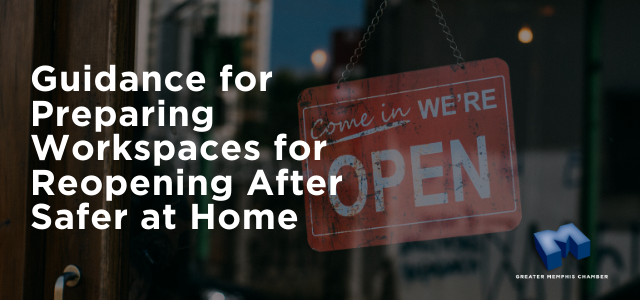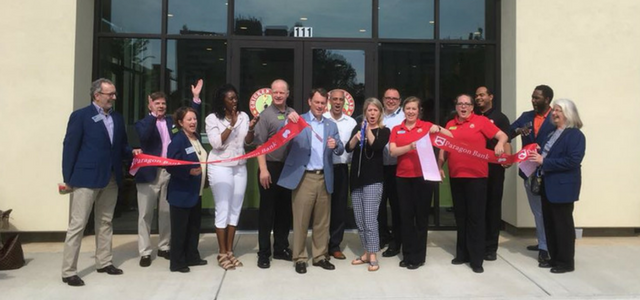
NOTE: The following information is intended to help businesses understand guidance provided by Memphis and Shelby County public and health officials for Phase 1 of Reopening Framework.
{{cta(’81b0ed24-084a-4787-9968-64cd2fe59e10′)}}
For an overview of which businesses can reopen during Phase 1, click here.
For full details of phased reopening guidance, visit the Shelby County Health Department’s website at http://www.shelbytnhealth.com and https://backtobusiness.memphistn.gov.
The following overview provides considerations for employers as they prepare their workplaces for repopulation. This information should not be considered legal guidance and may not apply to all employers and workplaces.
Prior to repopulating your workspace, businesses should prepare the work environment using a series of steps to help reduce introduction and transmission of COVID-19.
EVALUATING THE SPACE
The first step in preparing for reopening should be to conduct a thorough evaluation of your work environment. If you have a floor plan of your space, use it as a map to outline work stations and occupancy for each space, including conference rooms. If you do not have a floor plan of your office, conduct a walk thru to note number of work stations and seating capacity in each space.
Identify areas with high potential for introduction and transmission.
- Using either your floor plan or your walk thru, note areas in the workplace with surfaces that provide high introduction or transmission opportunities.
- Examples of high introduction and transmission risk areas include any space within the work environment where employees share space frequently such as office supply storage, copy machines, break areas, restrooms, lobbies, elevators and high traffic areas where employees or customers may “intersect” en route to other areas of the office.
CONSIDERATION: For high traffic areas, consider establishing a traffic pattern plan to circulate movement in only one direction within your work place. Communicate the traffic pattern to guests and employees. Use signage or tape on the floor to remind employees and guests of traffic patterns.
Establish protocols for communicating with staff about high risk areas, new traffic patterns and cleaning procedures to address introduction and transmission in common and shared spaces.
- Plan for regular staff communication and signage to help staff understand how to operate under the new standards.
- For those high-risk areas, make note to establish specific cleaning and sanitization procedures.
ESTABLISHING CAPACITY RULES, SEATING ARRANGEMENTS AND SAFE WORK STATIONS
The second step in preparing to the workspace for repopulation is to create a New Normal Capacity strategy to ensure social and physical distancing can happen within the work environment.
Note of Existing verses ‘New Normal’ capacity changes to be made.
For most businesses, capacity reduction and spacing will be critical to create a safe environment for work. When possible, move employees to individual workspaces within enclosed spaces with safe ventilation to best reduce introduction and transmission opportunities.
- Offices with doors can be repopulated as single occupancy workspaces without additional changes or modifications.
- Determine transmission potential of open work stations and cubicles and plan new seating arrangements to meet New Normal capacity reductions.
Spaces with high partitions may help reduce air droplet transmission and may allow for employees to safely remain in their regular workspaces. If open space or cubicle areas are not partitioned, employees will need to be spread out more. Consider placing employees in every other station in a checkerboard-type formation. - Identify enclosed spaces where workers could be transitioned to reduce spread. Small conference rooms, collaboration areas, supply areas and other enclosed spaces can be repurposed to allow for single occupancy.
- Reduce conference room seating by at least 50 percent. Remove and store excess chairs and seating to alleviate opportunity for overriding capacity rules in the space.
CONSIDERATION: For conference rooms and meeting spaces, determine the total allowed capacity for the space by taking the original seating capacity (not standing room) and reduce by at least 50 percent. Post the New Normal allowed capacity maximum for each conference and meeting area inside your workplace.
ADDITIONAL STEPS FOR PREPARING TO REPOPULATE THE WORK ENVIRONMENT
In advance of reopening, take the following additional steps before repopulating the workplace.
- Deep clean and disinfect your workplace.
- Clean and disinfect all surfaces in your workspace. For high risk areas, such as work stations, shared tools such as photocopiers, common areas, food service spaces and electronics. Be sure to include frequently touched surfaces such as elevator buttons and door handles.
CDC Guidance on Facility Cleaning Prior to Reopening can be found here.
- Clean and disinfect all surfaces in your workspace. For high risk areas, such as work stations, shared tools such as photocopiers, common areas, food service spaces and electronics. Be sure to include frequently touched surfaces such as elevator buttons and door handles.
- Evaluate ventilationand air flow in your workspace
- If you own your workspace, replace air filters with high efficiency filters if possible. Make changes to engineering controls and material to improve air filtration and circulation.
- If you rent your facility, ask your landlord to
- Replace HVAC air filters or clean/disinfect existing filters. Increase ventilation by opening windows or adjusting air conditioning.
- Place hand sanitizer stationsat key entry points.
- Provide hand sanitizer in multiple places at all entry points and throughout the work space.
- Place signage in alignment with locally outlined requirements.
- Place signs that promote the company’s health and safety protocol and procedures in prominent and frequently used areas.
- For a list of signage resource, click here.
SIGNAGE DETAILS
Signs should explain that the business is compliant with Health Department’s safety measures and that people should:
1. Avoid entering a public facility if they have a cough, fever or other symptoms of COVID-19.
2. Maintain a distance of at least six feet between individuals from people who are not members of the same household.
3. Engage in respiratory etiquette, including covering up coughs and sneezes and properly disposing of tissues.
4. Do not shake hands or engage in any unnecessary physical contact.
Example signage can be found here.
Free Signage Resources from the State of Tennessee can be found here.
For more resources and information related to building a resilient business post-COVID-19, visit the Greater Memphis Business Resource Center at www.memphischamber/covid19
Disclaimer: Some or all of the information contained in this overview may not be applicable to some businesses and may not include all necessary information for certain types of businesses. This guide does not attempt to address any health, safety or other work place requirements that were in place prior to March 2020 and the Safer at Home order for Memphis and Shelby County. As current circumstances continue to evolve, public health and safety recommendations, requirements and best practices will continue to evolve as well. To that end, this guide may not include the most recent governmental or health recommendations and requirements. We advise employers to carefully evaluate your environment and circumstances and consult with your own legal counsel and advisors regarding the legality applicability and value of this information in your specific place of business prior to implementing any of the guidance outlined in this document.
The Greater Memphis Chamber bears no responsibility for any circumstances or situations that arise out of or related to the adoption or decision not to adopt any of the recommendations, procedures or best practices referenced in this guide.
Have a question about reopening or restarting your business? Let us know.
{{cta(‘d3d5d701-6fbd-4e7d-88c1-61e31ef79d09’)}}



